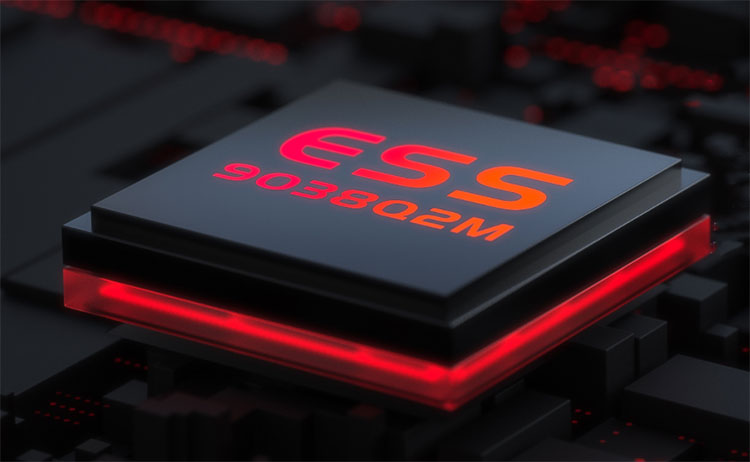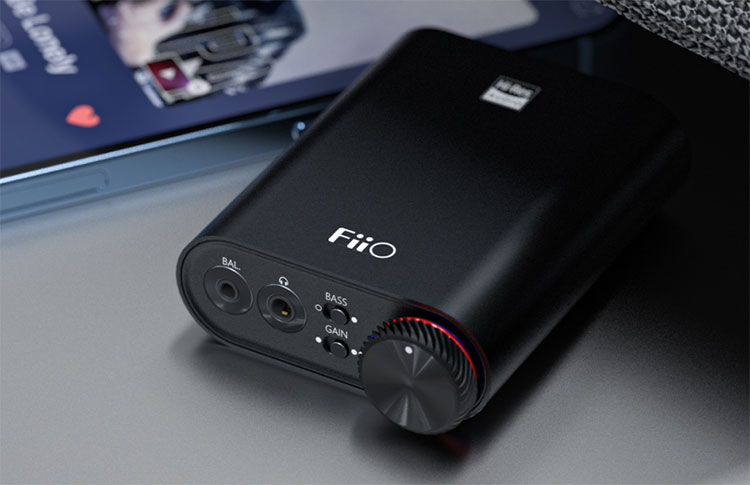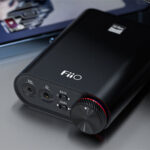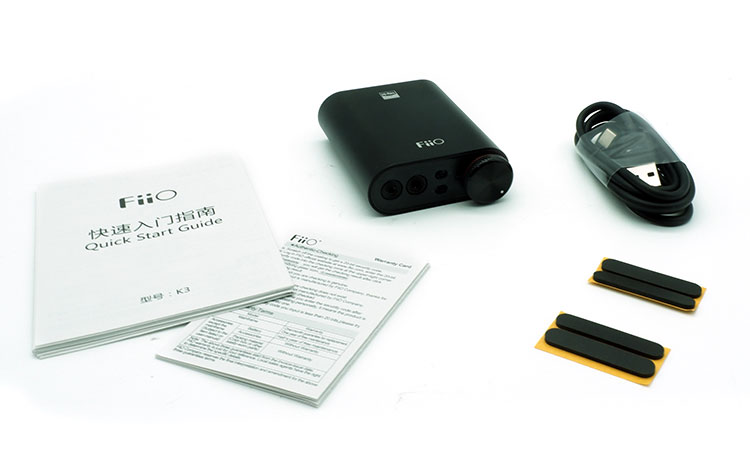FiiO New K3 is a compact desktop headphone amp using an ES9038Q2M DAC and capable of up to 200mW of output power. It is priced at $119.99
Disclaimer: The FiiO New K3 sent to us is a sample in exchange for our honest opinion in this review. We thank FiiO for this opportunity.
To learn more about FiiO reviews on Headfonics you can click here.
Note, this 2-page review follows our new scoring guidelines for 2021 which you can read up on here.
I’m sure I’m not the only one who remembers FiiO releasing a DAC/Amp that’s also called the K3. In fact, the original K3 has also come across our office for a thorough review 2 years ago.
However, with the changing times, FiiO has released a new version of the K3, called the ‘New K3’ or sometimes referred to as K3s on FiiO’s official website, and naturally enough comes with some improvements or upgrades.

Tech Highlights
While externally, the new K3 looks identical to the old K3 that was previously released, the internals have been overhauled and updated for 2021.
Internally, the new K3 has a standard XMOS XU208 USB controller, connected to a new UM8005 microcontroller. Also in the chain are dual oscillators that ensure accurate time-based reproduction of the analog signal.
The heart of the new K3 is an ES9038Q2M DAC chip, which is part of ESS Sabre’s top range 9038 series of DACs. This combination allows the new K3 to decode PCM streams up to 32bit/384kHz, and DSD256, which covers most of the files that are available in the market.
Downstream to the DAC chip is an SGM8264-2 opamp that’s configured to work as a low pass filter. Finally, the output section of the line out of the new K3 uses an OPA 1612 opamp as an output stage opamp to maintain the quality of the variable line-level outputs.
These components are all combined in a small aluminum chassis to ensure that the new K3 measures extremely accurately with a diminishingly low SNR of 121dB through the single-ended output, and 120dB through the balanced outputs.
The new K3 remains quiet while pushing quality power of up to 114mW into 32Ω through the single-ended output, and 200mW into 32Ω through the balanced outputs.
Design
Aesthetics
For a featured-packed little DAC/Amp, the new K3 keeps the same sleek aesthetic as the older K3. It’s still housed in a rounded aluminum chassis that’s painted in matte black to avoid some scratches or dings.
The front of the device has 2 outputs, then there are 2 black switches, and finally, there is a volume knob that doubles as a power switch with inlaid RGB LED lighting that indicates the sample rate.
On the rear of the device are the USB C input, and the digital and analog output options. Then there’s a switch at the rear of the device.
The entire device is black, except for some accents like the one on the volume knob, some branding, and the RCA jack at the rear, but this color choice allows the new K3 to easily blend in with a more clutter-free desktop setup.
FiiO also sends over the new K3 with 2 pairs of rubber feet that will keep the relatively light DAC/Amp from sliding around the table. With the new K3 being about the size of a pack of playing cards, it can easily be set up in some tight spaces without looking out of place.

I/O
At first glance, the new K3’s black paint job helps camouflage most of the available inputs and outputs. Upon closer inspection though, it has quite a bit going on.
In terms of input options, the new K3 is simple enough, allowing for a USB C input at the rear of the device. However, that USB C port can be switched over from USB audio class 2.0 to USB audio class 1.0. This means that the USB C port on the K3 can be made compatible even with some devices that can’t install the necessary drivers for USB audio class 2.0.
As for the output options, the new K3 has more output options than I expected from such a small device. In front of the device, there are 2 output options, being a 2.5mm balanced output with 220mW into 32Ω, and a 3.5mm single-ended output capable of 120mW at 32Ω.
There are 2 switches beside the outputs in front of the new K3, the first one is for bass boost, and the one below that is for gain control. This gives better control over the volume dial, making the K3 a more versatile device suitable for both headphones and IEMs.
At the rear of the device, I was surprised to see that there are 3 outputs. On the left side of the new K3, there is a variable line-level output that can be used for active speakers or an off-board amplifier.
On the right side, there are 2 digital output options, allowing for either a SPDIF output or an optical output for connection to another DAC which may only accept SPDIF/optical.
Controls
Being a mini desktop DAC/Amp, the K3 has relatively simple controls. There are 2 switches in front that control the extra bass and the gain settings. At the back of the device, there is a switch that allows switching over to USB audio class 1.0 to make it more widely compatible.
Then there’s the volume knob that also works as the power switch for the DAC. This volume knob is connected to an ADC chip that allows for precision volume control internally.
Around the volume knob is an RGB LED light that glows blue by default for Redbook CD sampling rates, yellow for anything above 48kHz, and green for any resolution of DSD.
Packaging & Accessories
When I was starting out in this hobby, FiiO used to send out their little DACs, or Amps in a cardboard box that is filled with accessories. While the box that arrived with the new K3 looks more modern, the idea remains the same, FiiO still fills the boxes to the brim with little goodies that they send over with the product itself.
The new K3 arrives in a white cardboard box with a picture of the product in front. Inside, there is another box wherein the K3 is fit in a foam insert to protect it from shaking, and then there is another box for the rest of the accessories.
Inside the smaller box, there is a USB C to USB A cable, which would typically be used with a full-sized desktop/Laptop. Also inside are 2 pairs of rubber feet that can fit under the new K3 to keep it from sliding. Finally, there is a quick start guide and a warranty card underneath all this.
Sound Impressions
Summary
As with most amplifiers, the new K3 is generally flat throughout the frequency response. Except that there is a hint of warmth that gives the bass a bit more weight compared to the rest of the frequency.
Generally, the new K3 is a DAC/Amp that doesn’t get in the way, instead, it conveys the music accurately while adding only a hint of coloration.
Timbre
While there is a mid-bass bump, the same doesn’t apply to the sub-bass region, which is generally linear. In the mid-bass region, the reproduction of drumbeats has a rounded and weighty presentation.
There is obvious heft behind each drumbeat, but the textures of the hit, as well as the hollowness of the tone are overshadowed by the heavier nature of drum hits. Bass guitar notes, therefore, maintain their heft, while having a flowy presentation.
With the new K3 only being powered by USB bus power, I expected that it would hit some kind of wall when it comes to the attack from drum hits. And in reality, the new K3 sounds slightly slower with quick drum hits, but the weight behind each hit still gives a sense of scale with each hit.
When talking about the midrange presentation, the new K3 can be thought of as honest. This means that vocal tracks have a very matter-of-fact presentation, making it easy to pick out textures in the vocal range. Also, this translates to allowing acoustic instruments to be conveyed accurately, allowing warmer instruments to sound warm, while brighter instruments remain sharp.
Part of what allows the midrange to be honest, is how the treble presentation remains relatively flat. Where harmonic overtones aren’t altered from the original, giving mid-range instruments and vocals a natural and honest presentation. Cymbal hits have a crystalline shimmer to them while having some texture with each hit.
The new K3 has an uptick in the upper treble frequencies, ensuring that it won’t be rolled off in any way. This allows more information about the air around the instruments to shine through while emphasizing the placement and spacing of the recording venue.
Staging & Dynamics
What’s impressive with the new K3 though is how well it separates instruments and vocalists within the soundstage. There is a good sense of space and air, easily presenting how the room is arranged, allowing the images to have a good sense of separation. The images formed are not as focused though, so they are not as chiseled as I have come to expect them to be.
While the new K3 doesn’t particularly make the soundstage any wider, it doesn’t get in the way of headphones or IEMs that already create a wide soundstage. The placement of images within the soundstage is fairly accurate in terms of directionality, but the images are not precisely localized.
Finally, the dynamic range of the new K3 is also impressive for its size and limited USB bus power. However, the limits of the USB C power don’t allow it to convey large crescendos so quickly, despite having the appropriate amount of weight behind those crescendos.
Also, gentler passages ultimately lack that sense of refinement and finesse, so gentler tinkling of the piano keys sounds more stubby than dainty.
Line Out
Running the line out of the K3 into my Topping A30 Pro, there is a notable improvement in many aspects. There is an improved sense of bass texture, while the attack of bass notes is more immediate.
While midrange texture is still honest, the fundamental of each note sounds more planted overall. With cymbal hits, each hit has more weight and it becomes more distinct from each other.
The most striking difference though is the ability of the new K3’s variable line-out section to create a more chiseled imaging presentation than simply running the onboard headphone amplifier. It just shows that the DAC section inside the new K3 can improve together with a better amplification section.
Click on page 2 below for pairings and select comparisons





